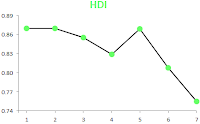This is a small research developed in a free time. It's concern some economic questions and European Union.
Introduction In a previous post I made a provocative question about the date of Croatian entrance in European Union (EU). It is probable that the date of entrance for Croatia will be in June 2013 according to the last news. However it is still interesting to check the modality of entrance in EU in accordance to some economics and developmental indices. The main hypothesis is that the order of entrance in the EU is according to i) wealth of the nation and ii) development of the nation. |
Materials & Methods
The EU countries were grouped according to the year of entrance in the EU (1 = 1957, 2 = 1973, 3 = 1981, 4 = 1986, 5 = 1995, 6 = 2004, 7 = 2007). For each country were collected several other economic variables. For each variable I made a Spearman correlation analysis.
Results & Discussion
The human developmental index (HDI) and the gross domestic product at purchasing power parity per capita (GDP) were highly correlated with the groups of nations and also between them (tab. 1). In the figures 1 and 2 it is visible how the average GDP and HDI per each group of nations is decreasing at each new group entrance. Remarkably the group 5 (corresponding to the group formed by Austria, Finland and Sweden entered in EU in 1995) it’s extremely high according to the position – like an outlier. This could be explained by an extremely late entrance in EU respect to the real possible date because of the particularly political and historical behaviour of these nations.
Furthermore the next year of entrance should be then somewhere between 2019 and 2023 when probably will enter the next group composed by Albania and Serbia. However due to the lowest HDI the last country should be Turkey but this country has the biggest GDP compared with Albania, Republic of Macedonia, Montenegro and Serbia.
Conclusion
Somebody could be interested if my model can predict the date of the entrance of single nations in EU. Well it cannot because you cannot make inference with this kind of statistics. Nevertheless I can only be sure that with high probability according to HDI and GDP Croatia should be in the next group.
Conclusion
Somebody could be interested if my model can predict the date of the entrance of single nations in EU. Well it cannot because you cannot make inference with this kind of statistics. Nevertheless I can only be sure that with high probability according to HDI and GDP Croatia should be in the next group.
It is obvious that large economically union such as EU grouped first important rich and developed countries, then the less developed and rich and only at the end the so called banana nations like Croatia. I think this is mainly due because of resources use. First the important countries finish their big piece of cake and then left the small countries only with the crumbs. Practically the more important countries offer crumbs to the less important countries tempting them to became a part of the union so they can economically eat them. Unfortunately this system is so good developed that the worst option should be to not enter in this large union as we will stop any our further development. European Union will get from Croatia and other small banana nations like Albania, Iceland, Montenegro, Republic of Macedonia, Serbia and Turkey more that these nations will receive from the EU but at least this nations will get something for their development otherwise they will go in a bigger crisis.




No comments:
Post a Comment